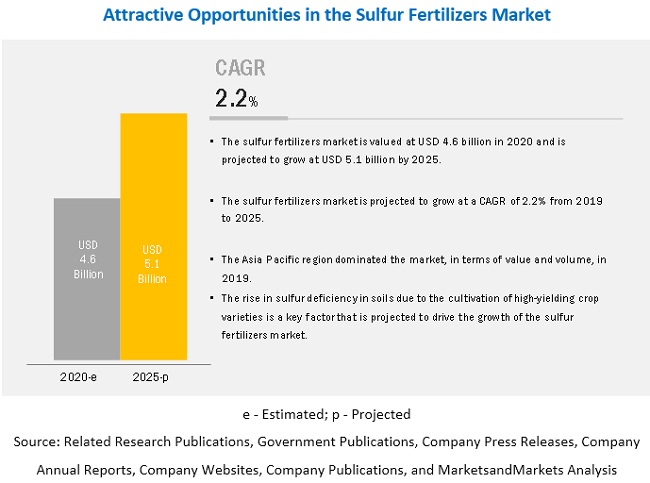
The global sulfur fertilizers market is estimated to be valued at USD 4.6 billion in 2020 and is projected to reach USD 5.1 billion by 2025, recording a CAGR of 2.2%. The growth of the sulfur fertilizers market is driven by various factors, such as the increase in sulfur deficiency in soils across the world due to strict regulations on sulfur emission and the cultivation of high-yielding crop varieties.
Download PDF brochure: https://www.marketsandmarkets.com/pdfdownloadNew.asp?id=212686493
Sulfate containing fertilizers offer advantages of providing sulfur in sulfate form, which is readily available for plant uptake. Sulfate-S is mobile in most soils, as it has a double negative charge and repels the negative charge of the soil, unlike nutrients, such as potassium, calcium, or magnesium. Sulfate form moves freely with soil moisture, particularly in the upper levels of the soil profile. The most readily available source of sulfate fertilizers is ammonium sulfate (AS), single superphosphate (SSP), potassium sulfate, and potassium and magnesium sulfate.
The soil application of sulfur fertilizers is the most commonly used mode of application due to the reduced cost of overall applications. Sulfur fertilizers can be applied in the soil through techniques, such as a broadcast, which helps in the uniform distribution of fertilizers on the soil surface. Widespread sulfur deficiencies in soils is a key factor that is projected to encourage the use of sulfur fertilizers through application in soils. Fertilizer manufacturers have introduced new products that can be broadcasted or banded to meet the increasing demand for sulfur.
The advantage of using dry fertilizers is that they have an extended shelf life and can provide nutrition to plants over an extended period of time. Thus, the increase in the consumption of granular or powdered sulfur fertilizers is a key factor that is projected to drive the growth of the dry segment in the sulfur fertilizers market. Furthermore, the launch of elemental sulfur enriched NPK fertilizers has also led to a high demand for the dry form of sulfur fertilizers.
The Rest of the World is segmented into South Africa, Turkey, and others in RoW, which includes Egypt, Morocco, Saudi Arabia, Iran, Israel, and Kenya. The agricultural activities in the African and Middle Eastern countries are carried out majorly, along the river banks and streams. Most farmers in these countries are small-scale and produce grains and other products for their own consumption and sale. However, farmers in a few Middle Eastern countries are gradually becoming aware of the benefits of sulfur fertilizers with the help of non-profit and non-governmental organizations.
Additionally, the high growth of the RoW region is supported by the increase in sulfur deficiency in the Middle Eastern and African regions.
Request Sample Pages: https://www.marketsandmarkets.com/requestsampleNew.asp?id=212686493
This report includes a study on the marketing and development strategies, along with a study on the product portfolios of the leading companies operating in the sulfur fertilizers market. It includes the profiles of leading companies, such as Nutrien, Ltd. (Canada), Yara International ASA (Norway), The Mosaic Company (US), ICL (Israel), K+S Aktiengesellschaft (Germany), Balchem Inc. (US), Compass Minerals (US), Sapec S.A. (Belgium), Tessenderlo Kerley, Inc. (Belgium), EuroChem Group (Switzerland), SQM S.A. (Chile), Zuari Agro Chemicals (India), Koch Industries, Inc. (US), The Kugler Company (US), Sulphur Mills (India), Coromandel International Ltd (India), Deepak Fertilizers and Petrochemicals Ltd. (India), Tiger-Sul Products LLC (US), Nufarm Limited (Australia), and Shell Sulphur Solutions (Netherlands).